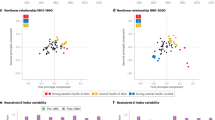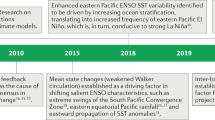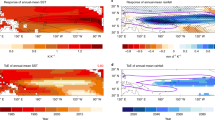Abstract
The destructive environmental and socio-economic impacts of the El Niño/Southern Oscillation1,2 (ENSO) demand an improved understanding of how ENSO will change under future greenhouse warming. Robust projected changes in certain aspects of ENSO have been recently established3,4,5. However, there is as yet no consensus on the change in the magnitude of the associated sea surface temperature (SST) variability6,7,8, commonly used to represent ENSO amplitude1,6, despite its strong effects on marine ecosystems and rainfall worldwide1,2,3,4,9. Here we show that the response of ENSO SST amplitude is time-varying, with an increasing trend in ENSO amplitude before 2040, followed by a decreasing trend thereafter. We attribute the previous lack of consensus to an expectation that the trend in ENSO amplitude over the entire twenty-first century is unidirectional, and to unrealistic model dynamics of tropical Pacific SST variability. We examine these complex processes across 22 models in the Coupled Model Intercomparison Project phase 5 (CMIP5) database10, forced under historical and greenhouse warming conditions. The nine most realistic models identified show a strong consensus on the time-varying response and reveal that the non-unidirectional behaviour is linked to a longitudinal difference in the surface warming rate across the Indo-Pacific basin. Our results carry important implications for climate projections and climate adaptation pathways.
This is a preview of subscription content, access via your institution
Access options
Subscribe to this journal
Receive 12 print issues and online access
$209.00 per year
only $17.42 per issue
Buy this article
- Purchase on Springer Link
- Instant access to full article PDF
Prices may be subject to local taxes which are calculated during checkout




Similar content being viewed by others
References
McPhaden, M. J., Zebiak, S. E. & Glantz, M. H. ENSO as an integrating concept in earth science. Science 314, 1740–1745 (2006).
Philander, S. G. H. Anomalous El Niño of 1982–83. Nature 305, 16 (1983).
Cai, W. et al. Increasing frequency of El Niño events due to greenhouse warming. Nature Clim. Change 4, 111–116 (2014).
Power, S., Delage, F., Chung, C., Kociuba, G. & Keay, K. Robust twenty-first-century projections of El Niño and related precipitation variability. Nature 502, 541–545 (2013).
Santoso, A. et al. Late-twentieth-century emergence of the El Niño propagation asymmetry and future projections. Nature 504, 126–130 (2013).
Guilyardi, E. El Niño-mean state-seasonal cycle interactions in a multi-model ensemble. Clim. Dynam. 26, 329–348 (2006).
Collins, M. et al. The impact of global warming on the tropical Pacific Ocean and El Niño. Nature Geosci. 3, 391–397 (2010).
Stevenson, S. L. Significant changes to ENSO strength and impacts in the twenty-first century: Results from CMIP5. Geophys. Res. Lett. 39, L17703 (2012).
Chavez, F. P., Ryan, J., Lluch-Cota, S. E. & Ñiquen, M. From anchovies to sardines and back: Multidecadal change in the Pacific Ocean. Science 299, 217–221 (2003).
Taylor, K. E., Stouffer, R. J. & Meehl, G. A. An overview of CMIP5 and the experimental design. Bull. Am. Meteorol. Soc. 93, 485–498 (2012).
Rayner, N. A. et al. Global analyses of sea surface temperature sea ice, and night marine air temperature since then late nineteenth century. J. Geophys. Res. 108, 4407 (2003).
Smith, T. M., Reynolds, R. W., Peterson, T. C. & Lawrimore, J. Improvements to NOAA’s historical merged land-ocean surface temperature analysis (1880–2006). J. Clim. 21, 2283–2296 (2008).
Sun, D-Z. El Niño: A coupled response to radiative heating? Geophys. Res. Lett. 24, 2031–2034 (1997).
Fedorov, A. V. & Philander, G. Is El Niño changing? Science 288, 1997–2002 (2000).
Van Oldenborgh, G. J., Philip, S. Y. & Collins, M. El Niño in a changing climate: A multi-model study. Ocean Sci. 1, 81–95 (2005).
McPhaden, M. J., Lee, T. & McClurg, D. El Niño and its relationship to changing background conditions in the tropical Pacific Ocean. Geophys. Res. Lett. 38, L15709 (2011).
Kim, S. T. & Jin, F-F. An ENSO stability analysis. Part I: Results from a hybrid coupled model. Clim. Dynam. 36, 1593–1607 (2011).
Tokinaga, H. & Xie, S-P. Wave- and Anemometer-based sea surface wind (WASWind) for climate change analysis. J. Clim. 24, 267–285 (2011).
Large, W. G. & Yeager, S. G. The global climatology of an interannually varying air–sea flux data set. Clim. Dynam. 33, 341–364 (2009).
Luebbecke, J. & McPhaden, M. J. Assessing the 21st century shift in ENSO variability in terms of the Bjerknes stability index. J. Clim. 27, 2577–2587 (2014).
Jin, F-F. An equatorial ocean recharge paradigm for ENSO. Part I: Conceptual model. J. Atmos. Sci. 54, 811–829 (1997).
An, S-I. & Jin, F-F. Nonlinearity and asymmetry of ENSO. J. Clim. 17, 2399–2412 (2004).
Jin, F-F., Kim, S. T. & Bejarano, L. A coupled-stability index of ENSO. Geophys. Res. Lett. 33, L23708 (2006).
Kim, S. T., Cai, W., Jin, F-F. & Yu, J-Y. ENSO stability in coupled climate models and its association with mean state. Clim. Dynam. 42, 3313–3321 (2013).
Ren, H. & Jin, F-F. Recharge oscillator mechanisms in two types of ENSO. J. Clim. 26, 6506–6523 (2013).
Wang, B., Wu, R. & Fu, X. Pacific-East Asian teleconnection: How does ENSO affect East Asian climate? J. Clim. 13, 1517–1536 (2000).
Vecchi, G. & Soden, B. Global warming and the weakening of the tropical circulation. J. Clim. 20, 4316–4340 (2007).
Xie, S-P. et al. Global warming pattern formation: Sea surface temperature and rainfall. J. Clim. 23, 966–986 (2010).
Carton, J. A. & Giese, B. S. A reanalysis of ocean climate using Simple Ocean Data Assimilation (SODA). Mon. Weath. Rev. 136, 2999–3017 (2008).
Uppala, S. M. et al. The ERA-40 re-analysis. Q. J. R. Meteorol. Soc. 131, 2961–3012 (2005).
Acknowledgements
We acknowledge the World Climate Research Programme’s Working Group on Coupled Modelling, which is responsible for CMIP, and we thank the climate modelling groups for producing and making available their model output. For CMIP the US Department of Energy’s Program for Climate Model Diagnosis and Intercomparison provides coordinating support and led development of software infrastructure in partnership with the Global Organization for Earth System Science Portals. S.T.K. is supported by CSIRO Office of Chief Executive and Wealth from Oceans Flagship, and W.C. is supported by the Australian Climate Change Science Program, and a CSIRO Office of Chief Executive Science Leader award. A.S. is supported by the Australian Research Council. S-I.A. is supported by the National Research Foundation of Korea Grant funded by the Korean Government (NRF-2009-C1AAA001-2009-0093042).
Author information
Authors and Affiliations
Contributions
S.T.K. and W.C. designed the study. S.T.K. performed the data analysis. S.T.K. and W.C. wrote the initial manuscript. All authors discussed the results and contributed to improvement of the manuscript.
Corresponding authors
Ethics declarations
Competing interests
The authors declare no competing financial interests.
Supplementary information
Rights and permissions
About this article
Cite this article
Kim, S., Cai, W., Jin, FF. et al. Response of El Niño sea surface temperature variability to greenhouse warming. Nature Clim Change 4, 786–790 (2014). https://doi.org/10.1038/nclimate2326
Received:
Accepted:
Published:
Issue Date:
DOI: https://doi.org/10.1038/nclimate2326
This article is cited by
-
Inter-model robustness of the forced change of the ENSO-Indian Summer Monsoon Teleconnection
npj Climate and Atmospheric Science (2024)
-
Reconciling opposite trends in the observed and simulated equatorial Pacific zonal sea surface temperature gradient
Geoscience Letters (2023)
-
Anthropogenic impacts on twentieth-century ENSO variability changes
Nature Reviews Earth & Environment (2023)
-
Interdecadal wind stress variability over the tropical Pacific causes ENSO diversity in an intermediate coupled model
Climate Dynamics (2023)
-
ENSO atmospheric feedbacks under global warming and their relation to mean-state changes
Climate Dynamics (2023)



